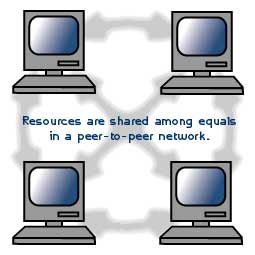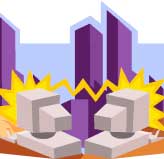The bright side of P2P
 Despite legal disputes in the field of online music copyright, peer-to-peer (P2P) technology still has many undeniable practical values.
Despite legal disputes in the field of online music copyright, peer-to-peer (P2P) technology still has many undeniable practical values.
Imagine an ideal information storage system for the globe. The system can quickly identify and send a file (potentially very large) among millions of files anywhere in the world. In order to ensure this feature, the system can be able to configure itself, recover from the incident rather than the ' central control ' mechanism such as the currently popular storage system. In addition, the system must also secure, support millions of users simultaneously, be able to ' immune ' to attacks - both physical attacks and attacks through software, dangerous code. harm.
Of course, administrators are always ' dreaming ' about such a system, especially when the Internet is increasingly becoming an important determinant of business success. In fact, the ideal system has actually existed in the form of peer-to-peer networks (eg eDonkey, KaZaA).
P2P technology has been used by millions of digital music enthusiasts to share music files. This fact itself poses many copyright issues and touches the rights of record companies. In the US and Europe, many music and film companies have lobbied, pressing the court to make decisions to 'erase' P2P technology. Not long ago, the group of 'harmed' companies even sued to the US Supreme Court for patent and popular individuals to pay compensation. Not stopping there, some Justice Department officials also said that the use of P2P networks is to support terrorism! The technology has also been condemned as an illegal channel to distribute pornographic content online.
Of course P2P also has the left side that needs methods to control and restrict. However, this technology also has many aspects that need to be acknowledged. The 'rationale' is that the power and security of the Internet will be improved thanks to strange software piracy, but in fact thanks to the superior and P2P features that have existed for many years. Instant- despite physical, technical and legal attacks.
' P2P + digital music piracy ' - the widespread bad word drowned out the fact that P2P technology has been applied in many areas: from content distribution, making Internet-based calls to Storage applications and search support etc. P2P technology is a new approach that supports the construction of a large, large-scale computing system.
From a technical perspective, ' peer-to-peer ' refers to the ability of direct interaction between two computers to install an application software, not through intermediary computers. The connection model can make many people think of the Internet, but P2P has its own characteristics.
Back in time, the Internet was originally designed to be decentralized. However, the Internet is increasingly seaward in the direction of a ' one-axis-multiple ' (hub-and-spoke). The personal computers in the network connect to the central server to perform tasks such as sending / receiving email, browsing the web, etc. The network used to include many peer computers, both producing and consuming content. Now, it is no different from television sets waiting for signals from the base station.
The power of the majority
 P2P connects computers directly to each other, and immediately after the connection, personal computers can perform tasks that they cannot perform when standing alone. Most P2P systems allow users to share resources, including processing capabilities, storage capacity and bandwidth. In the case of sharing music files, the actual user has shared the system of files through which all network participants can download their favorite music files. According to CacheLogic ( UK-based P2P service company ), more than 50% of network traffic comes from peer-to-peer applications. Meanwhile, Internet research company BigChampagne (based in Beverly Hills, California) claims that more than 10% of peer-to-peer content is legal.
P2P connects computers directly to each other, and immediately after the connection, personal computers can perform tasks that they cannot perform when standing alone. Most P2P systems allow users to share resources, including processing capabilities, storage capacity and bandwidth. In the case of sharing music files, the actual user has shared the system of files through which all network participants can download their favorite music files. According to CacheLogic ( UK-based P2P service company ), more than 50% of network traffic comes from peer-to-peer applications. Meanwhile, Internet research company BigChampagne (based in Beverly Hills, California) claims that more than 10% of peer-to-peer content is legal.
The most active "pulsed" P2P system, accounting for about 35% of network traffic (according to CacheLogic), is named BitTorrent. This is a completely free open source project, supporting the storage and transmission of extremely large files. Taking advantage of being an illegal way to share music files, compensated BitTorrent is also a huge support channel for companies in the process of providing large files to users ( movies, games, software applications such as Linux operating system .).
BitTorrent has been successful in part thanks to the incentive application users are willing to give and receive. A statistic conducted in 2000 about P2P networks showed that nearly 70% of users have never shared files; In addition, nearly half of the files in the database are contributed by only about 1% of users. According to Bram Cohen (BitTorrent founder), the BitTorrent system has basically solved this problem by committing to prioritizing download speeds of members actively contributing content. In addition, BitTorrent uses swarming technology, which splits files into small packets and circulates in the network. For example, two users can download the same file at the same time, they can share the downloaded packets to speed up through the download.
 The effectiveness of P2P networks has prompted many initiatives to form legitimate P2P distribution services. LionShare, based at PennState University, uses P2P programs to encourage training information sharing around the world. Next up is Kontiki, the application identified by BBC news agency as a method for effective distribution of online programs. Kontiki puts a portion of large files on member PCs worldwide to speed up the sharing process. Similarly, Red Swoosh operates a P2P network to share legal, copyrighted content. ' Why can't we turn the technology that the entertainment industry is afraid of into something they really need ?', Travis Kalanick, Red Swoosh chairman, put it, ' The problem seems very complicated. legally, but it is very simple if we go in the right direction '.
The effectiveness of P2P networks has prompted many initiatives to form legitimate P2P distribution services. LionShare, based at PennState University, uses P2P programs to encourage training information sharing around the world. Next up is Kontiki, the application identified by BBC news agency as a method for effective distribution of online programs. Kontiki puts a portion of large files on member PCs worldwide to speed up the sharing process. Similarly, Red Swoosh operates a P2P network to share legal, copyrighted content. ' Why can't we turn the technology that the entertainment industry is afraid of into something they really need ?', Travis Kalanick, Red Swoosh chairman, put it, ' The problem seems very complicated. legally, but it is very simple if we go in the right direction '.
One of P2P's dependents is the Internet Archive, a non-profit digital library run by Brewster Kahle, a San Francisco-based business owner. The data warehouse uses up to five P2P systems so that it can distribute both audio (audio) and animation (video) without having to "freak out" about the transmission bandwidth problem. According to Mr. Kahle, if not thanks to P2P, only big companies with abundant financial resources will have enough money to distribute large amounts of audio and video online.
Compliance with the P2P approach eliminates the inherent weaknesses of the Internet. Specifically, using applications such as BitTorrent, the more requested content is 'run' to the user's computer with faster speed. However, the fact is that P2P is much more versatile than a normal file distribution application. Clearly, the ' P2P idea ' has transformed quite a lot from KaZaA to Skype-Internet voice service using P2P structure. Groove Networks, another company, uses P2P simulation to provide network space for coordination of online activities. Most simply, Groove Networks' system allows two or more people to edit a file. P2P system is also the most effective solution to carry out backup services for Internet-based files. In addition, you can also build search engines, through which suggestions on documents based on user-defined indexes (eg Amazone suggests books). good books based on the number of customers purchased, etc.).
' P2P is a perfectly natural and perfect evolution of the Internet. In fact, P2P brought the Internet back to its original form - in line with the ideas of the early Internet founders, "said Ian Clarke, founder of FreeNet (an P2P network that requires anonymity).
Even when discussing the origin of the Internet for military purposes, the US military is also studying P2P applications on the battlefield. Rather than distributing hierarchical information, it would be more effective if military personnel share information over peer-to-peer networks. Some military radios have been operating under the P2P mechanism: Radio uses self-configuration technology called ' Mesh Networking ' - in which each radio can play the role of relaying and transmitting signals to radios. vicinity.
Along with the tendency to decentralize and share resources, you will most likely be attracted to the flow of thinking that the Internet is becoming a large, sociable community. However, Huberman's chief information officer for Information Dynamics Lab (HP) argues: ' P2P is a structure, which we need is a market mechanism .' Under this mechanism, P2P users need to be compensated for the computing loops, storage capacity as well as the bandwidth they share. Huberman's work also builds a system called Tycoon capable of quantifying and 'auctioning' excess computing power on users' computers. This feature, according to Huberman, is extremely important to be able to develop P2P from 'volunteer' applications into serious applications chosen by large companies.
Peer pressure
Obviously the threat from legal cases is still the biggest challenge for P2P dissemination efforts. In the case of Napster, when peer-to-peer music sharing networks have been closed since 2001, many investors 'falter' before deciding to invest in P2P technology (even legitimate P2P forms). ). This is also understandable.
Meanwhile, programmers continue to pore over the lines of code. P2P does not need to have a "mission" to confirm its validity. P2P is just a technology, you can pull it out of the box or take it away, 'said a programmer.
 Wireless technology: Too many options
Wireless technology: Too many options UWB Technology: Promising future
UWB Technology: Promising future Share Internet connection with wired model
Share Internet connection with wired model Wireless network journey: From Wi-Fi to WiMax
Wireless network journey: From Wi-Fi to WiMax What is VLAN? How to configure a VLAN on Cisco Switch?
What is VLAN? How to configure a VLAN on Cisco Switch? Learn about basic WLAN devices
Learn about basic WLAN devices